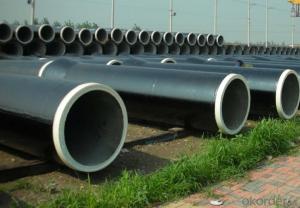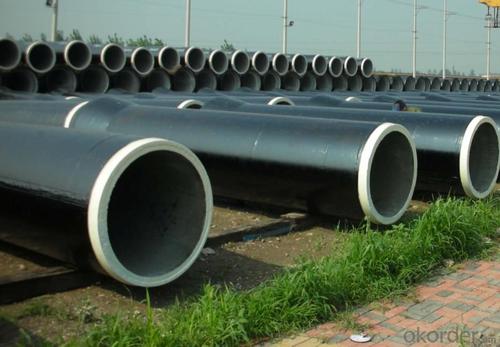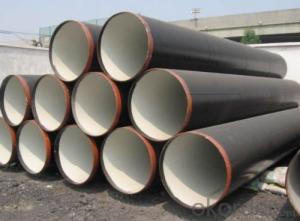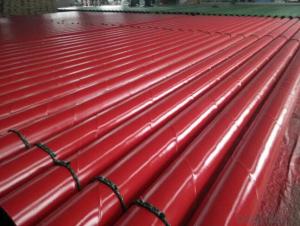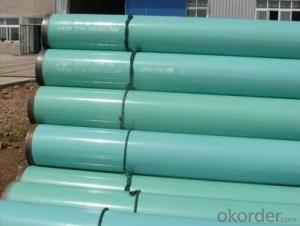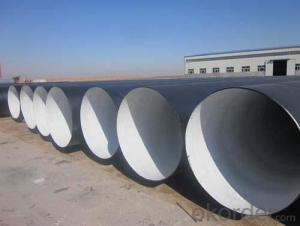HIGH QUALITY 3PE COATED STEEL PIPE
- Loading Port:
- China Main Port
- Payment Terms:
- TT OR LC
- Min Order Qty:
- -
- Supply Capability:
- -
OKorder Service Pledge
OKorder Financial Service
You Might Also Like
Packaging & Delivery
| Packaging Detail: | Plastic plugs in both ends Hexagonal bundles of max. 2000kg with several steel strips Two tags on each bundle Wrapped in waterproof paper PVC sleeve and sackcloth with several steel strips Plastic caps |
| Delivery Detail: | within 45 days after confirmation |
Specifications
API 5L PSL1/PSL2 Gr.B/X42/X52/X56/X60/X65/X70/X80 3PE/FBE Coated Line Pipe
OD: 2"-30",
WT:0.250"-4"
L:random,fixed,SRL,DRL
Application
Used for construction of long distance pipelines for combustible liquids and gases, nuclear station pipelines, heating system pipelines, general-purpose pipelines, vessels manufacturing, mechanical engineering and instrumental engineering.
DISTINCTIVES FEATURES
A) The External surface is shot-blasted (Sa 2 1/2) by removing millscale and rust, obtaining metal surface to facilities the adhesion.
B) The pipe is heated in a electric or gas oven at a controlled temperature.
C) The adhesive is then applied by hot meit or copolymer. It binds the polythylene to the steel.
D) Immediately afterwards, the extruded polyethylene/polyprophylene is coated on the pipe.
E) After application of the polyethylene/polyprophylene, the pipe is coated by spraying water.
Process
SEAMLESS
HOT ROLLED
COLD DRAWN
WELDED
ERW (Electric Resistance Welded)
HFI (High Frequency Induction)
EFW(ELECTRIC FUSION WELDED TUBE)
LSAW (Longitudinal Submerge-arc Welded) UO(UOE),RB(RBE),JCO(JCOE)
DSAW (Double Submerged arc welded)
SAW (Spiral Welded)
SSAW (Spiral Submerged-arc Welded)
Quality Standard
SEAMLESS PROCESS
GB/T 8163 Seamless steel tubes for liquid service
ASTM A106 Standard Specification for Seamless Carbon Steel Pipe for High-Temperature Service
DIN 1629 SEAMLESS CIRCULAR TUBES OF NON ALLOY STEELS WITH SPECIAL QUALITY REQUIREMENTS
API 5L Line Pipe
WELDED PROCESS
ERW HFI , EFW, LSAW, DSAW
GB/T3091 Welded steel pipe for low pressure liquid delivery
GB/T9711 Petroleum and natural gas industries--Steel pipe for pipelines
EN10217 Welded steel tubes for pressure purposes.
IS 3589 Steel tubes for water and sewage
IS 1978-1982 Steel tubes for use in transportation of oil; gas & Petroleum products
BS 1387 Steel Tubes for use for Water, Gas, Air and Steam
ASTM A53 Standard Specification for Pipe, Steel, Black and Hot-Dipped, Zinc-Coated, Welded and Seamless
DIN 2458 WELDED STEEL PIPES AND TUBES
API 5L Line Pipe
SAW SSAW
SY/T5037 Spiral submerged arc-welded steel pipe for pipelines for low pressure field fluid service
SY/T 5040 Spiral submerged arc-welded steel pipe piles
CJ/T 3022 Spiral submerged-arc welded steel pipe for municipal heat supply
IS 1978 Steel tubes for use in transportation of oil; gas & Petroleum products
API 5L Line Pipe
Coating Standard
ANSI/AWWA C104/A21.4 American National Standard for Cement-Mortar Lining for Ductile-Iron Pipe and Fittings for Water
ISO 21809 Petroleum and natural gas industries -- External coatings for buried or submerged pipelines used in pipeline transportation systems
DIN 30670 Polyethylen coatings of steel pipes and fittings
Steel Grade
SEAMLESS PROCESS
GB/T 8163 10# 20# 35# 45# 16MN(Q345B)
GB 3087 10# 20# 35# 45# 16MN(Q345B)
GB 5310 20G 12Cr1MoV 12Cr1MoVG 12CrMoG
ASTM A106 Gr A Gr B Gr C
DIN 1629 St 37.0 St 44.0 St 52.0
API 5L A B X42X46 X52 X60 X65 X70 X80
WELDED PROCESS
GB/T3091 SY/T5037 SY/T 5040CJ/T 3022
Q195 Q215 Q235 Q275 Q295 Q345 08F 08 08AL 08F 10F 10 HG5 DF08 SPHC M8
BS 1387 EN10217 S185 S235 S235JR S235 G2H S275 S275JR S355JRH S355J2H St12 St13 St14 St33 St37 St44 ST52
ASTM A 53 Gr. A Gr B Gr C Gr.D
API 5L A B X42 X46 X52 X56 X60 X65 X70
GB/T9711 L175 L210 L245 L290 L320 L360 L290 L320 L360 L390 L415 L450 L485 L555
Size
SEAMLESS PROCESS
Outer Diameter Hot finish 2" - 30" Cold drawn 0.875" - 18"
Wall Thickness Hot finish 0.250" - 4.00" Cold drawn 0.035" - 0.875"
Length Random Length Fixed Length SRL DRL
WELDED PROCESS
ERW HFI EFW
Outer Diameter 6mm-610mm (1/16"-24")
Wall Thickness 0.3mm-22mm
Length 0.5mtr-20mtr
LSAW DSAW
Outer Diameter 219mm-1820mm
Wall Thickness 5.0mm-50mm
Length 6mtr-18mtr
SAW SSAW
Outer Diamter 219.1mm - 4064mm (8" - 160")
Wall Thickness 3.2 mm - 40mm
Length 6mtr-18mtr
End
square ends (straight cut saw cut and torch cut);
beveled for welding (All line piping is square cut to the tolerance specified and bevelled to ANSI B16.25. An angle of 30º (-0º +5º) and a landing of 16 mm ±08 mm is applied. Schedule 160 material is supplied without bevelling.)
Surface Lightly oiled Hot dip galvanized Electro galvanized Black Bare Varnish coating/Anti rust oil Protective Coatings (Coal Tar Epoxy Fusion Bond Epoxy 3-layers PE)
Test Chemical Component Analysis Mechanical Properties (Ultimate tensile strength Yield
strength Elongation) Technical Properties (Flattening Test Bending Test Hardness Test Blow Test Impact Test etc.) Exterior Size Inspection Hydrostatic Test(The standard pressure is limited to 207 MPa (3000 psi)) X-ray Test.
Mill Test Certificate EN 10204/3.1B
Third party inspection SGS BV Lloyds etc.
- Q: What are the different methods of protecting steel pipes from external damage?
- There are several methods of protecting steel pipes from external damage, including coating the pipes with a corrosion-resistant material such as epoxy or polyethylene, applying a layer of protective tape, installing a cathodic protection system, using concrete or rock shielding, and implementing measures to prevent soil movement or impact damage.
- Q: What are the common problems or issues faced with steel pipes?
- Common problems or issues faced with steel pipes include corrosion, leakage, cracking, and scaling. Corrosion can occur due to exposure to moisture, chemicals, or environmental factors, leading to reduced structural integrity and potential leaks. Leakage can result from faulty welds, damaged seals, or pipe degradation. Cracking can occur due to excessive stress, temperature fluctuations, or manufacturing defects, compromising the pipe's strength. Scaling or buildup of mineral deposits can also restrict flow and affect performance. Regular inspection, maintenance, and proper coating or lining can help mitigate these issues.
- Q: What is the creep resistance of steel pipes?
- The ability of steel pipes to withstand deformation or elongation over time when exposed to high temperatures and constant stress is referred to as their creep resistance. Steel pipes are highly regarded for their exceptional resistance to creep because of the inherent strength and stability of the material. The creep resistance of steel pipes can vary depending on factors like the composition of the alloy, heat treatment, and the conditions in which they are used. Creep is a phenomenon that occurs at elevated temperatures, causing materials to slowly deform under constant stress. In the case of steel pipes, this can be a concern in applications where they are subjected to high temperatures for extended periods, such as in power plants, industrial furnaces, or steam pipelines. The ability to resist creep deformation is crucial to maintain the structural integrity and longevity of the pipes. Steel pipes are often designed and manufactured using alloys with high creep resistance properties, such as chromium-molybdenum (Cr-Mo) steels or nickel-based alloys. These alloys possess excellent mechanical strength, thermal stability, and resistance to oxidation and corrosion, all of which contribute to their superior creep resistance. Moreover, heat treatment processes like quenching and tempering can significantly enhance the creep resistance of steel pipes. These treatments involve controlled heating and cooling cycles to optimize the microstructure of the steel, thereby increasing its resistance to deformation and improving its overall performance at high temperatures. It is important to note that the creep resistance of steel pipes is typically specified by industry standards and codes, such as the American Society of Mechanical Engineers (ASME) Boiler and Pressure Vessel Code. These standards define the allowable stress levels and design criteria for different steel pipe applications, ensuring that they meet the necessary safety and performance standards. In summary, steel pipes are renowned for their excellent creep resistance due to their inherent strength, stability, and ability to withstand high temperatures. The specific creep resistance of steel pipes may vary depending on factors such as alloy composition, heat treatment, and operating conditions. Proper design and adherence to industry standards are essential to ensure the desired creep resistance and overall performance of steel pipes in various applications.
- Q: What is the difference between steel pipe and copper pipe?
- The main difference between steel pipe and copper pipe lies in their material composition. Steel pipe is made of steel, while copper pipe is made of copper. Steel pipe is stronger and more durable, making it suitable for high-pressure and heavy-duty applications. On the other hand, copper pipe is more malleable and corrosion-resistant, making it ideal for plumbing and water supply systems. Additionally, copper pipe is more expensive than steel pipe but offers better heat conductivity, making it suitable for heating and cooling applications.
- Q: How are steel pipes used in the construction of nuclear power plants?
- Steel pipes are used in the construction of nuclear power plants for various purposes, such as transporting and containing fluids and gases, including coolant, steam, and compressed air. They are specifically chosen for their high strength, durability, and resistance to heat and pressure. Steel pipes are used in the construction of primary and secondary cooling systems, reactor vessels, and other critical components, ensuring the safe and efficient operation of nuclear power plants.
- Q: How are steel pipes used in the marine industry?
- Steel pipes are widely used in the marine industry for various applications such as shipbuilding, offshore structures, and underwater pipelines. They provide strength, durability, and corrosion resistance, making them suitable for transporting fluids, gases, and other materials in harsh marine environments. Steel pipes are also used for constructing piers, docks, and oil rigs, as well as for supporting and reinforcing marine structures.
- Q: What are the different methods of joining steel pipes without welding?
- There are multiple ways to connect steel pipes without welding. These include: 1. Mechanical Couplings: These couplings consist of two separate pieces that attach to the pipe ends and then tighten together. They provide a secure and leak-proof connection, eliminating the need for welding. 2. Threaded Connections: This method involves threading the ends of the steel pipes to create a male and female connection. The pipes are then screwed together using pipe threads, creating a strong and dependable joint. 3. Flanged Connections: Flanges are utilized to connect steel pipes by bolting them together. The flanges have a flat surface with holes that align with corresponding holes in the opposing flange. Bolts are inserted and tightened to establish a tight seal. 4. Grooved Connections: This technique involves grooving the pipe ends and using grooved couplings to join them. The couplings have teeth that interlock with the grooves, resulting in a secure and rigid connection. 5. Compression Fittings: Compression fittings are employed to connect steel pipes by compressing a metal or plastic ring onto the outer surface of the pipe. This creates a tight seal and a reliable connection without welding. 6. Adhesive Bonding: Special adhesives designed for bonding metals can be used to connect steel pipes. The adhesive is applied to the pipe surfaces, which are then pressed together and left to cure, forming a strong and durable bond. 7. Clamping: Clamps can be used to hold steel pipes together, creating a temporary connection. This method is commonly used for testing purposes or in situations where the pipes need to be easily dismantled. Each of these methods has its own benefits and limitations, and the choice depends on various factors such as the specific application, pipe material, and required joint strength.
- Q: What are the common methods for cleaning the inner surface of steel pipes?
- There are several common methods for cleaning the inner surface of steel pipes. Some of the most widely used methods include: 1. Mechanical Cleaning: This method involves the use of mechanical tools such as wire brushes, scrapers, or abrasive pads to physically remove debris, rust, or scale from the inner surface of the steel pipe. This method is effective for removing loose or loosely adhered contaminants. 2. Chemical Cleaning: Chemical cleaning involves the use of acidic or alkaline solutions to dissolve or loosen stubborn deposits, rust, or scale on the inner surface of steel pipes. The solution is usually circulated through the pipe for a specific period of time, allowing the chemical to react and break down the contaminants. This method is often used when mechanical cleaning is not sufficient. 3. High-Pressure Water Jetting: In this method, high-pressure water is directed through a nozzle into the steel pipe, effectively removing debris, rust, or scale from the inner surface. The force of the water jet helps dislodge and flush out the contaminants. This method is particularly efficient for cleaning pipes with complex geometries or hard-to-reach areas. 4. Shot Blasting: Shot blasting involves the use of high-speed abrasive particles propelled against the inner surface of the steel pipe to remove rust, scale, or other contaminants. This method is commonly used for larger pipes or pipes with heavy deposits. It provides a thorough and uniform cleaning by removing the surface layer of the steel along with the contaminants. 5. Ultrasonic Cleaning: Ultrasonic cleaning uses high-frequency sound waves to create microscopic bubbles in a cleaning solution. These bubbles implode upon contact with the inner surface of the steel pipe, effectively loosening and removing contaminants. This method is particularly effective for cleaning small-diameter pipes or pipes with intricate details. It is important to note that the selection of the cleaning method depends on various factors such as the type and extent of contamination, pipe size and geometry, and the desired level of cleanliness. Additionally, proper safety measures should always be taken when performing any cleaning method to ensure the protection of workers and the integrity of the steel pipes.
- Q: Can steel pipes be used for oil refineries?
- Yes, steel pipes are commonly used in oil refineries due to their high strength, durability, and resistance to corrosion, making them suitable for transporting various petroleum products and chemicals within the refinery infrastructure.
- Q: How do you calculate the pipe friction loss coefficient for steel pipes?
- To determine the pipe friction loss coefficient for steel pipes, it is necessary to take into account several factors. One commonly used approach is the utilization of the Darcy-Weisbach equation, which establishes a relationship between the frictional head loss in a pipe and the flow rate, pipe diameter, pipe length, fluid properties, and the pipe roughness coefficient. The Darcy-Weisbach equation can be presented as follows: The head loss due to friction, denoted as hf, can be calculated using the formula (f * L * V^2) / (2 * g * D), where: - f represents the pipe friction factor, - L corresponds to the pipe length, - V denotes the fluid velocity, - g symbolizes the acceleration due to gravity, and - D represents the pipe diameter. Determining the pipe friction factor, f, is crucial. For steel pipes, this factor relies on the pipe roughness coefficient, which indicates the relative roughness of the pipe. The relative roughness is determined by dividing the absolute roughness of the pipe surface by the pipe diameter. The pipe roughness coefficient can be obtained from different sources, including manufacturer specifications, engineering handbooks, or experimental data. It is imperative to ensure that the roughness coefficient used aligns with the specific type and condition of the steel pipe under analysis. Once the pipe roughness coefficient is obtained, it can be employed to calculate the pipe friction factor through empirical correlations or charts. These correlations often involve the Reynolds number, a dimensionless quantity that characterizes the flow regime. By substituting the determined pipe friction factor into the Darcy-Weisbach equation, it becomes possible to calculate the head loss due to friction for steel pipes. This value is indispensable in the design of piping systems, determination of pump requirements, or estimation of energy consumption in fluid flow applications.
Send your message to us
HIGH QUALITY 3PE COATED STEEL PIPE
- Loading Port:
- China Main Port
- Payment Terms:
- TT OR LC
- Min Order Qty:
- -
- Supply Capability:
- -
OKorder Service Pledge
OKorder Financial Service
Similar products
Hot products
Hot Searches
Related keywords
